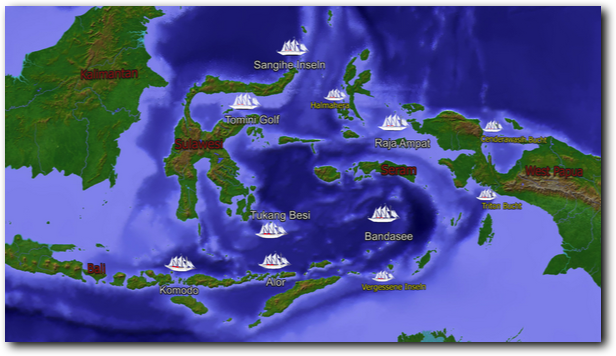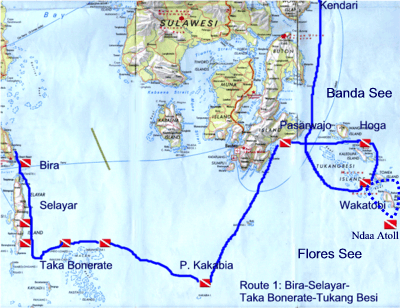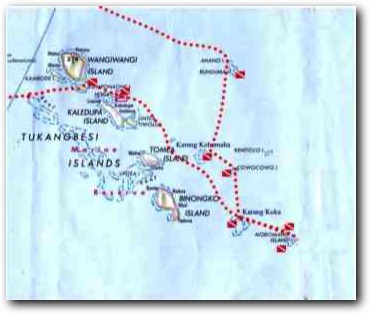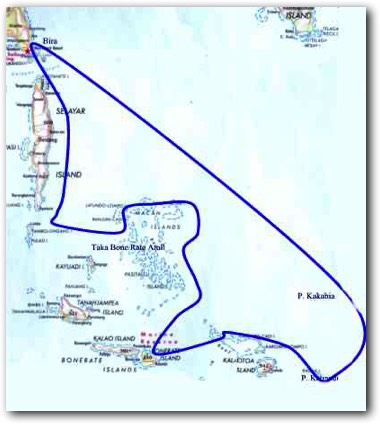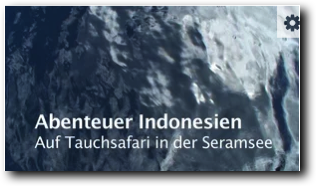Compass
Liveaboard Diving in Indonesia
A liveaboard trip in Indonesia is always something special. Covering more than 17,000 islands in the center of the coral triangle, this island kingdom spans over 5000 kilometers on either side of the equator and is home to the biggest marine biodiversity in the world.
The ship has always been the most important means of travel in this island world, and for divers in particular, a comfortable and well-powered dive ship is the means of choice when it comes to discovering the waters of Indonesia from the diver's perspective.
While 30 years ago, when I started diving in Indonesia, divers were still limited to land-based diving destinations in Bali and North Sulawesi, with only a handful of liveaboard trips being offered, this has changed dramatically in the time since. Everywhere in Indonesia diving tours are offered with more or less well-equipped ships, which usually sail according to a fixed timetable. In recent years, regional priorities have emerged and in these areas, the competition between liveaboard operators has increased significantly.
The ship has always been the most important means of travel in this island world, and for divers in particular, a comfortable and well-powered dive ship is the means of choice when it comes to discovering the waters of Indonesia from the diver's perspective.
While 30 years ago, when I started diving in Indonesia, divers were still limited to land-based diving destinations in Bali and North Sulawesi, with only a handful of liveaboard trips being offered, this has changed dramatically in the time since. Everywhere in Indonesia diving tours are offered with more or less well-equipped ships, which usually sail according to a fixed timetable. In recent years, regional priorities have emerged and in these areas, the competition between liveaboard operators has increased significantly.
Shipbuilding in Indonesia
Many liveaboards in Indonesia are built in Tana Beru, in the south of Sulawesi. This place boasts of a century-old shipbuilding tradition. The famous Indonesian pinisi were built here. Pinisi are two-masted sailing ships, which even today carry out a part of the freight traffic between the islands of Indonesia.
The fact that the boatbuilders of Tana Beru still have a lot to do today and that the tradition of shipbuilding is not extinct is due not least to the construction of liveaboard vessels, which have been built in considerable numbers since the turn of the millennium in the shipbuilding yards of Tana Beru.
I have documented the construction of one of these diving vessels, the Amira. After almost two years of construction and an investment of more than 1.5 million euros, the Amira was finally pulled into the water.
Today, the Amira is one of the best known liveaboard vessels in Indonesia. This liveaboard is most of the year in Raja Ampat or in Komodo.
Many liveaboards in Indonesia are built in Tana Beru, in the south of Sulawesi. This place boasts of a century-old shipbuilding tradition. The famous Indonesian pinisi were built here. Pinisi are two-masted sailing ships, which even today carry out a part of the freight traffic between the islands of Indonesia.
The fact that the boatbuilders of Tana Beru still have a lot to do today and that the tradition of shipbuilding is not extinct is due not least to the construction of liveaboard vessels, which have been built in considerable numbers since the turn of the millennium in the shipbuilding yards of Tana Beru.
I have documented the construction of one of these diving vessels, the Amira. After almost two years of construction and an investment of more than 1.5 million euros, the Amira was finally pulled into the water.
Today, the Amira is one of the best known liveaboard vessels in Indonesia. This liveaboard is most of the year in Raja Ampat or in Komodo.
This is particularly evident in the Komodo region, where especially in the high season between May and September, many dive ships cruise between Bali and Komodo.
While it is quieter in Komodo between November and April, it is getting very busy in the Raja Ampat area off the west coast of New Guinea. Most dive operators have adapted to this seasonal change and are relocating their ships along the monsoon seasons in Indonesia.
There are only a few ships that stay in one place all year round and also offer dive trips in the rainy season. For dive trips off the well-known routes, there is only a small time window every year which can be used, due to the the pronounced monsoon times. Schedules are usually set up to two (sometimes more) years in advance and you need to get together with the boat owners very early if you want to offer a liveaboard trip that takes you to places which have not been or rarely visited by scuba divers before.
For the owners, this is not at least a financial risk, because no one can guarantee them that the ship is sold out in the end. As more distance is covered on such journeys than on the direct route, additional costs for fuel and for the solution of logistical problems, which must always be expected in remote areas of Indonesia, must also be taken into account. No wonder that many dive operators are not enthusiastic about such ideas and prefer to focus on their bread-and-butter itineraries. Nevertheless, there are always some adventurous providers, with whom you can organize something out of the way.
While it is quieter in Komodo between November and April, it is getting very busy in the Raja Ampat area off the west coast of New Guinea. Most dive operators have adapted to this seasonal change and are relocating their ships along the monsoon seasons in Indonesia.
There are only a few ships that stay in one place all year round and also offer dive trips in the rainy season. For dive trips off the well-known routes, there is only a small time window every year which can be used, due to the the pronounced monsoon times. Schedules are usually set up to two (sometimes more) years in advance and you need to get together with the boat owners very early if you want to offer a liveaboard trip that takes you to places which have not been or rarely visited by scuba divers before.
For the owners, this is not at least a financial risk, because no one can guarantee them that the ship is sold out in the end. As more distance is covered on such journeys than on the direct route, additional costs for fuel and for the solution of logistical problems, which must always be expected in remote areas of Indonesia, must also be taken into account. No wonder that many dive operators are not enthusiastic about such ideas and prefer to focus on their bread-and-butter itineraries. Nevertheless, there are always some adventurous providers, with whom you can organize something out of the way.
Video: On a liveaboard to Triton Bay
The best time for such special dive trips are April to May and October to November when the Indonesian Dive Ship Armada embarks on its annual cruise from Komodo to Raja Ampat through the Banda Sea. These two time windows between northwest and southeast monsoon also offer favorable conditions for longer trips due to wind and weather conditions, also the sea is often calmer during this time than during the rest of the year.
First of all, let's take a look at the dive safaris in Indonesia, which I above somewhat disparagingly referred to as bread and butter rides. Anyone who has undertaken only dive trips in the Red Sea and experienced the pack formation of often more than 15 live aboards at an anchorage will definitely be thrilled by live aboard trips in Indonesia. Even in the hotspots Komodo and Raja Ampat, which are heavily frequented by tourists, you will seldom see many other dive ships during the 7 to 12-day tours. One usually remains on these tours among themselves and can enjoy the dive sites without interference from divers of other vessels.
First of all, let's take a look at the dive safaris in Indonesia, which I above somewhat disparagingly referred to as bread and butter rides. Anyone who has undertaken only dive trips in the Red Sea and experienced the pack formation of often more than 15 live aboards at an anchorage will definitely be thrilled by live aboard trips in Indonesia. Even in the hotspots Komodo and Raja Ampat, which are heavily frequented by tourists, you will seldom see many other dive ships during the 7 to 12-day tours. One usually remains on these tours among themselves and can enjoy the dive sites without interference from divers of other vessels.
Liveaboard diving trips in Nusa Tenggara (Komodo/Flores/Alor)
Komodo National Park is one of the oldest national parks in Indonesia. Originally set up to protect the world's only giant monitor lizards on the island of Komodo and the neighboring island of Rinca, the National Park has become also an underwater national park. Thanks to the protection the amount of fish and the coral reefs around Komodo are among the healthiest and most diverse in the world.
Video: Liveaboard Diving from Labuan Bajo
Video: Animated Liveaboard Diving Trip from Bali to Komodo
Video: From Bali to Komodo
Liveaboards either travel directly from Bali to Komodo or they take their guests aboard after flying to Labuan Bajo on Flores or Bima on Sumbawa. From there the dive boats reach the dive spots in the National Park, which are mostly located between Komodo and Rinca. The latter tours are usually shorter than those starting in Bali and are focused on the park's diving highlights, including a ranger-led hike to the Komodo Dragons.
The dive trips starting in Bali are usually longer and offer additional diving opportunities on the way to Komodo off Lombok and Sumbawa. Often these trips end in Labuan Bajo, where the next tour group goes on board, whose final destination is Bali again.
The dive trips starting in Bali are usually longer and offer additional diving opportunities on the way to Komodo off Lombok and Sumbawa. Often these trips end in Labuan Bajo, where the next tour group goes on board, whose final destination is Bali again.
Alor
In combination with Komodo also occasional trips are offered further east to the island of Alor. Tours of this type often start in Labuan Bajo or Maumere and then continue along the coast from Flores via Maumere to the east.
After staying for several days in the Pantar Strait between the islands of Pantar and Alor, the ships return to Maumere.
Anyone who has the chance to take part in such a journey, should do so. Alor is next to Komodo the second hotspot of maritime biodiversity in the chain of islands wihich form the Nusa Tenggara Islands.
After staying for several days in the Pantar Strait between the islands of Pantar and Alor, the ships return to Maumere.
Anyone who has the chance to take part in such a journey, should do so. Alor is next to Komodo the second hotspot of maritime biodiversity in the chain of islands wihich form the Nusa Tenggara Islands.
Video: Liveaboard Diving Trip to Alor
Liveaboard Diving Trips in Raja Ampat
For about 15 years Raja Ampat is on everyone's lips in the diving community. When I first visited Raja Ampat in 2003, there was only one dive center in the entire area, which is about half the size of Austria. This has changed dramatically in recent years. Almost every year new dive centers are opened and there are now more than 60 liveaboards cruising the Raja Ampat area between October and April.
Mind you: these ships are spread over a total area of 183,000 km². It is therefore unlikely that you will meet during a tour many other liveaboards. (With the exception of Dampier Strait, where it seems to be getting more and more crowded nowadays.) Often you are completely alone on the cruise for days.
For more information on the outstanding role of Raja Ampat as a hotspot of biodiversity between Pacific and Indian Ocean have a lokk on my reports on the BodeWeb.
So what do the normal Raja Ampat trips look like?
All Raja Ampat live aboard trips start in Sorong, a port city on the so-called bird's head of West Papua, the Indonesian part of the island of New Guinea. After a stopover in Jakarta, Bali or Manado, the guests of the various dive ships fly into Sorong sometimes with further stopovers and are met at the airport by representatives of the different live aboards and then transported by minibus to the port and from there directly to the ships.
Sometimes formalities still need to be clarified, but overall the transfer of guests has accelerated significantly in recent years because the local authorities have also developed a routine in dealing with strangers who want to dive in Raja Ampat. Afterwards, the dive ships leave Sorong Bay as fast as possible and first dives can be done a in the early afternoon near the island of Batanta.
Mind you: these ships are spread over a total area of 183,000 km². It is therefore unlikely that you will meet during a tour many other liveaboards. (With the exception of Dampier Strait, where it seems to be getting more and more crowded nowadays.) Often you are completely alone on the cruise for days.
For more information on the outstanding role of Raja Ampat as a hotspot of biodiversity between Pacific and Indian Ocean have a lokk on my reports on the BodeWeb.
So what do the normal Raja Ampat trips look like?
All Raja Ampat live aboard trips start in Sorong, a port city on the so-called bird's head of West Papua, the Indonesian part of the island of New Guinea. After a stopover in Jakarta, Bali or Manado, the guests of the various dive ships fly into Sorong sometimes with further stopovers and are met at the airport by representatives of the different live aboards and then transported by minibus to the port and from there directly to the ships.
Sometimes formalities still need to be clarified, but overall the transfer of guests has accelerated significantly in recent years because the local authorities have also developed a routine in dealing with strangers who want to dive in Raja Ampat. Afterwards, the dive ships leave Sorong Bay as fast as possible and first dives can be done a in the early afternoon near the island of Batanta.
Raja Ampat: The North
Both tour options lead through the Raja Ampat core area, the Dampier Strait between the elongated island of Mansuar and Waigeo in the north. When taking the northern route these diving highlights are usually at the beginning of the trip.
Here all liveaboards dive the reefs in the area of the Papua Dive Resort and in front of Waigeo with large schools of fish. There are at least two Manta cleaning stations in the area, where you can observe with luck very large manta rays.
Then the ships follow the west coast of Waigeo and continue further north where they finally reach Wayag, the northernmost point of the Raja Ampat area. Wayag is a fantastic Mini-Palau with many small islands and lagoons. From there the journey usually goes back to Sorong via Fam and Gam.
Here all liveaboards dive the reefs in the area of the Papua Dive Resort and in front of Waigeo with large schools of fish. There are at least two Manta cleaning stations in the area, where you can observe with luck very large manta rays.
Then the ships follow the west coast of Waigeo and continue further north where they finally reach Wayag, the northernmost point of the Raja Ampat area. Wayag is a fantastic Mini-Palau with many small islands and lagoons. From there the journey usually goes back to Sorong via Fam and Gam.
Animation: Raja Ampat North
Raja Ampat: The South
Ships choosing the south route will visit the central Raja Ampat area on the way back. Often, the captains choose the narrow and relatively flat seaway between the mainland and Salawati to reach the top dive sites off Misool on the fastest and shortest route.
There, the ships stay for several days and dive at Farondi, Daram and Wayil. Afterwards, they cruise back north along Batanta's west coast to Dampier Strait, with the aforementioned dive sites around the Papua Dive Resort, and finally end up in Sorong.
There, the ships stay for several days and dive at Farondi, Daram and Wayil. Afterwards, they cruise back north along Batanta's west coast to Dampier Strait, with the aforementioned dive sites around the Papua Dive Resort, and finally end up in Sorong.
Animation: Raja Ampat South & North
Raja Ampat & East-Halmahera
Another Raja Ampat variant is the extension of the north route to the east. There you will reach the Moluccan island of Halmahera. The eastern side of this island has not been dived very often yet. In Weda Bay there there is also a diving resort which and can be visited during this liveaboard trip.
As Standardwing Birds of Paradise (Semioptera wallacii) can be observed in the vicinity of the resort, excursions can also be made on land. The route then returns to Sorong via the northern Raja Ampat Islands (Wayag, Kawe).
As Standardwing Birds of Paradise (Semioptera wallacii) can be observed in the vicinity of the resort, excursions can also be made on land. The route then returns to Sorong via the northern Raja Ampat Islands (Wayag, Kawe).
Animation: Raja Ampat & East-Halmahera
Video: Liveaboard Diving Trip from Raja Ampat to East-Halmahera
Video: Liveaboard Diving Trip from Raja Ampat to West-Halmahera
Liveaboard Diving Trip toTriton Bay
With a bit of luck you can also take part in a liveaboard trip to the southeast of the bird's head peninsula, to Triton Bay.
In the spring of 2006, an expedition of the WWF and Conservation International had discovered 52 new species in this part of the Vogelkop area.
What the public at that time did not know, however was the fact that the expedition's main destination was Triton Bay, which in the eyes of the scientists involved represented the real surprise of this expedition in terms of biodiversity.
In order to protect the bay, which at that time had no protection status at all the scientists agreed on complete silence on the Triton Bay discoveries. Therefore, on my first visit to Triton Bay in 2007, I also had to commit to not publishing accurate information on this new biodiversity hotspot in Indonesia.
Meanwhile, the conservation status of Triton Bay has improved and Conservation International has established a permanent research station at the entrance to the bay, opposite one of the best dive sites, which now ensures adequate control of the area.
Most liveaboards start for a trip to Triton Bay in Sorong. On the way they dive around Misool, the Pisang islands and finally reach Triton bay after a visit of the Mormon waterfall. Then it's back to Sorong. Occasionally the guests leave in Kaimana or the tour is continued across the Banda Sea and ends in Ambon.
In the spring of 2006, an expedition of the WWF and Conservation International had discovered 52 new species in this part of the Vogelkop area.
What the public at that time did not know, however was the fact that the expedition's main destination was Triton Bay, which in the eyes of the scientists involved represented the real surprise of this expedition in terms of biodiversity.
In order to protect the bay, which at that time had no protection status at all the scientists agreed on complete silence on the Triton Bay discoveries. Therefore, on my first visit to Triton Bay in 2007, I also had to commit to not publishing accurate information on this new biodiversity hotspot in Indonesia.
Meanwhile, the conservation status of Triton Bay has improved and Conservation International has established a permanent research station at the entrance to the bay, opposite one of the best dive sites, which now ensures adequate control of the area.
Most liveaboards start for a trip to Triton Bay in Sorong. On the way they dive around Misool, the Pisang islands and finally reach Triton bay after a visit of the Mormon waterfall. Then it's back to Sorong. Occasionally the guests leave in Kaimana or the tour is continued across the Banda Sea and ends in Ambon.
Video: Liveaboard Diving Trip Raja Ampat & Triton Bay
Cenderawasih Bay
Liveaboards that stay in the Raja Ampat area all year round also offer tours to Cenderawasih Bay in the north of West Papua during the summer months.
In the European summer months, the weather is quieter here and visibility is better than in the rest of the Raja Ampat area.
Starting point of such dive trips is again Sorong or Manokwari on the north coast. In addition to excursions to the beaches of Jamursba-Medi, where leatherback turtles lay their eggs every year in the months of July and August, wreck dives and a visit to the stationary whale sharks in Kwatisore Bay are normally on the agenda.
In the European summer months, the weather is quieter here and visibility is better than in the rest of the Raja Ampat area.
Starting point of such dive trips is again Sorong or Manokwari on the north coast. In addition to excursions to the beaches of Jamursba-Medi, where leatherback turtles lay their eggs every year in the months of July and August, wreck dives and a visit to the stationary whale sharks in Kwatisore Bay are normally on the agenda.
Animation: Liveaboard Diving Trip to Cenderawasih Bay
Once in a Lifetime Liveaboard Diving Trips in Indonesia
Banda Sea Diving on a Liveaboard
As already described in the introduction, the months of the monsoon change between April / May and October / November are particularly suitable for exceptional liveaboard journeys. Then the ships are on their annual migration from east to west or vice versa and there is one or the other possibility to deviate from the course.
Animation: On a Liveaboard across the Banda Sea
The classic among these tours is the Banda Sea Crossing, which is offered by many dliveaboard operators in two sections. The tours usually start in fall in Maumere on Flores (in spring in Sorong) and follow the north coast from Flores to Alor.
From there the ships cruise along the west coast of Wetar and then turn to the northeast to the snake island Gunung Api. Gunung Api is the Indonesian word for fire mountain, ie volcano. The small island is home to a large number of ultra-poisonous, olive-green sea snakes, which one encounters everywhere while diving. Without doubt these dives are nothing for divers with weak nerves!
Then the trip continues in an easterly direction to the Penyu and Lucipara Islands, the summits of huge submarine volcanoes, which protrude from depths of over 4000 m to just above the water surface. In the crystal clear waters of the Banda Sea there is always the chance of encounters with pelagics and huge schools of fish.
Afterwards you reach the Banda Islands with a rich colonial history, nutmeg plantations and excellent dive sites.
The next destinations are Nusa Laut in the south of the island Seram and finally Ambon with excellent macro dive sites in Ambon bay.
In Ambon the second part of the Banda Sea crossing begins. Often the ships then make another turn back to the Banda Islands and continue their journeyf from there along the east coast of Seram in a northerly direction.
From Misool, the ships usually follow the route of the normal Raja Ampat south route to Sorong. Individual ships also offer a swing to Triton Bay. You should therefore compare the itineraries exactly.
From there the ships cruise along the west coast of Wetar and then turn to the northeast to the snake island Gunung Api. Gunung Api is the Indonesian word for fire mountain, ie volcano. The small island is home to a large number of ultra-poisonous, olive-green sea snakes, which one encounters everywhere while diving. Without doubt these dives are nothing for divers with weak nerves!
Then the trip continues in an easterly direction to the Penyu and Lucipara Islands, the summits of huge submarine volcanoes, which protrude from depths of over 4000 m to just above the water surface. In the crystal clear waters of the Banda Sea there is always the chance of encounters with pelagics and huge schools of fish.
Afterwards you reach the Banda Islands with a rich colonial history, nutmeg plantations and excellent dive sites.
The next destinations are Nusa Laut in the south of the island Seram and finally Ambon with excellent macro dive sites in Ambon bay.
In Ambon the second part of the Banda Sea crossing begins. Often the ships then make another turn back to the Banda Islands and continue their journeyf from there along the east coast of Seram in a northerly direction.
From Misool, the ships usually follow the route of the normal Raja Ampat south route to Sorong. Individual ships also offer a swing to Triton Bay. You should therefore compare the itineraries exactly.
Animation: On a Liveaboard across the Banda Sea (Ambon nach Maumere)
Video: On a Liveaboard across the Banda Sea
The Wild East of Indonesia: The Forgotten Islands
Since 2011 some liveaboard operators offer trips to the 'Forgotten Islands of Indonesia', another variant of the Banda Sea crossing.
According to a book published in 1995 (Nico de Jonge, Toos van Dijk, The Forgotten Islands of Indonesia: The Art and Culture of Southeastern Moluccas, Singapore 1995), the region of the southeastern Maluku Islands (Maluku Tenggara) are known as the forgotten islands of Indonesia. It is not a narrowly defined area but an island chain that stretches over a distance of almost 1000 km from Timor to West Papua on the island of New Guinea.
These underdeveloped and sparsely populated islands are far off the beaten track. As they have not been of any economic or touristic interest, people live there more or less isolated from the rest of Indonesia and the rest of the world.
According to a book published in 1995 (Nico de Jonge, Toos van Dijk, The Forgotten Islands of Indonesia: The Art and Culture of Southeastern Moluccas, Singapore 1995), the region of the southeastern Maluku Islands (Maluku Tenggara) are known as the forgotten islands of Indonesia. It is not a narrowly defined area but an island chain that stretches over a distance of almost 1000 km from Timor to West Papua on the island of New Guinea.
These underdeveloped and sparsely populated islands are far off the beaten track. As they have not been of any economic or touristic interest, people live there more or less isolated from the rest of Indonesia and the rest of the world.
Animation: Liveaboard Diving Trip to the Forgotten Islands of Indonesia
Video: Liveaboard Diving Trip to theForgotten Islands of Indonesia
Liveaboard trips to the forgotten islands are still very explorative in nature. You have to be prepared to get involved in a real adventure, as there is little knowledge of the dive sites yet. Diving is at potentially interesting places. But you always have to be prepared to pull one or two rivets.
The tours usually end on the island of Tanimbar. From there it is easy to fly out via Ambon. From Tanimbar, the journey then continues via the Kei and Watubelo Islands north through the Raja Ampat area to Sorong.
The tours usually end on the island of Tanimbar. From there it is easy to fly out via Ambon. From Tanimbar, the journey then continues via the Kei and Watubelo Islands north through the Raja Ampat area to Sorong.
Raja Ampat & Seram Sea
Another variant of the Banda Sea Crossing includes the Moluccan island Halmahera and sometimes the north coast of Seram into the tour. In spring the safari starts in Sorong.
After a night cruise, Misool is reached with its world-class dive sites. Afterwards, the trip continues to Seram, where there are very nice diving opportunities on the north coast.
After Seram, the cruise turns north, passes the Pisang Islands and eventually reaches the southern tip of Halamahera with large schools of fish and good macro dive sites.
In the Manta Bay at the Goraici Islands there is the chance to see manta rays. The first part of the tour ends in Ternate. From there you can continue the safari to the south with diving in front of Seram and in Ambon.
After a night cruise, Misool is reached with its world-class dive sites. Afterwards, the trip continues to Seram, where there are very nice diving opportunities on the north coast.
After Seram, the cruise turns north, passes the Pisang Islands and eventually reaches the southern tip of Halamahera with large schools of fish and good macro dive sites.
In the Manta Bay at the Goraici Islands there is the chance to see manta rays. The first part of the tour ends in Ternate. From there you can continue the safari to the south with diving in front of Seram and in Ambon.
Video: Raja Ampat & Seram Sea
Liveaboard Diving Trips in the South of Sulawesi
Only in the inter-monsoon season from April to mid-May and October to mid-November the islands in the south and southeast of Sulawesi can be dived safely. During the rest of the year, many of the Taka Bonerate and Tukang Besi archipelago's (Wakatobi) most interesting reefs are located in direct impact of the monsoon winds due to their exposed location. These constantly blowing winds cause high waves and make it safe anchoring and diving difficult.
The islands in the south and southeast of Sulawesi include Selayar Island, the Taka Bonerate Archipelago, Buton Island, the Tukang Besi Archipelago and some scattered volcanic islands stretching from depths of up to 3000 meters between the Taka Bonerate Archipelago to the west and the Tukang Besi islands in the east.
The exposed location of these islands has meant that so far only a few divers could visit these remote islands. Jacques Cousteau was here in the 80s. He came to the conclusion that he has found here the "possibly best diving area in the world".
For several years now, large parts of this area have been monopolized by the Wakatobi Dive Resort. With the help of local rulers and certainly a few donations to the local police, the resort has been able to push out annoying competition from liveaboards in the Wakatobi region. Despite these annoyances one still finds operators, who offer occasional tours also in this region of Indonesia.
Three possible tour options are available:
The islands in the south and southeast of Sulawesi include Selayar Island, the Taka Bonerate Archipelago, Buton Island, the Tukang Besi Archipelago and some scattered volcanic islands stretching from depths of up to 3000 meters between the Taka Bonerate Archipelago to the west and the Tukang Besi islands in the east.
The exposed location of these islands has meant that so far only a few divers could visit these remote islands. Jacques Cousteau was here in the 80s. He came to the conclusion that he has found here the "possibly best diving area in the world".
For several years now, large parts of this area have been monopolized by the Wakatobi Dive Resort. With the help of local rulers and certainly a few donations to the local police, the resort has been able to push out annoying competition from liveaboards in the Wakatobi region. Despite these annoyances one still finds operators, who offer occasional tours also in this region of Indonesia.
Three possible tour options are available:
The Southern Islands of Sulawesi
This liveaboard trip leads from Kendari first to Pasarwajo, where first-rate Critter dive sites can be found. The walls of Hoga then offer very good reef dives with the opportunity to see huge schools of fish. We also used to dive the reefs of Wakatobi Dive Resort. Presumably, this is currently not possible because of the situation described above.
Afterwards the journey leads via Batuata to the uninhabited island of Kakabia with excellent deep-sea dive sites. Along the north side of the Taka Bonerate Atoll, with beautifully overgrown walls, we then head west to the coast of Selayar. Here you will find very nice dive sites in the area near the Selayar Dive Resort, where are in contrast to the Wakatobi Dive Resort, the owner is pleased tom welcome passing by guests.
The tour ends in Bira with strong currents and the possibility to observe at Cape Bira and Pulau Kambing a lot of sharks.
The Eastern Atolls
In the east of the Tukang Besi Islands in Indonesia lay scattered more small islands and atolls. Jacques Cousteau's basecamp was located on Moromaho, a small island located on the easternmost edge of this archipelago. From here he explored the diving grounds of the region.
Also this liveaboard trip begins in Kendari, but then leads further east into the Banda Sea to the remote atolls Ronduma, Karang Kohomaha, Karan Koka and Moromaho.
Afterwards follow dives in Hoga, Kakabia or Batuata from where the ship cruises to the southern tip of Selayar. From here the tour leads along the east coast of Selayar back to Bira.
The Deep South
This tour leads from Bira to the south along the east coast of Selayar. From there it continues along the north coast of the Taka Bonerate Atoll to the east to dive the steep walls off Kakabia. Further south follow dives in front of Kaunadi, then the cruise turns in a wide arc past the island of Madu back to the north.
This tour leads from Bira to the south along the east coast of Selayar. From there it continues along the north coast of the Taka Bonerate Atoll to the east to dive the steep walls off Kakabia. Further south follow dives in front of Kaunadi, then the cruise turns in a wide arc past the island of Madu back to the north.
Videos: Liveaboard Diving Trips in Indonesia
On the video platform Vimeo, I've been collecting videos from underwater filmmakers who have been doing liveaboard trips in Indonesia for several years.
The collection is sorted by dive regions in Indonesia into albums so you can target underwater videos of the dive area you want to travel to.
Here you can see what other divers have experienced and filmed on dive trips in Indonesia. So you can get a relatively objective picture of the underwater world of the diving area that you would like to visit on a liveaboard in Indonesia.
The collection is sorted by dive regions in Indonesia into albums so you can target underwater videos of the dive area you want to travel to.
Here you can see what other divers have experienced and filmed on dive trips in Indonesia. So you can get a relatively objective picture of the underwater world of the diving area that you would like to visit on a liveaboard in Indonesia.

